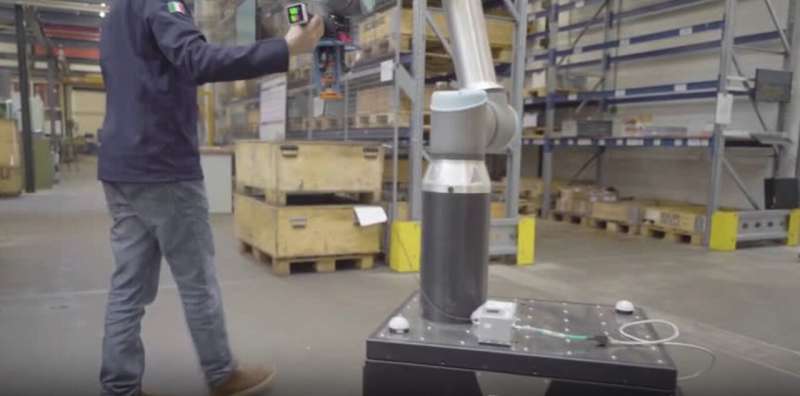This article has been reviewed according to Science X's editorial process and policies. Editors have highlighted the following attributes while ensuring the content's credibility:
fact-checked
trusted source
proofread
Enhancing ergonomics in industrial domains with 'cobots' and intelligent wearable systems

At the 2024 European Robotics Forum taking place in Rimini, Italy, researchers of Istituto Italiano di Tecnologia (IIT- Italian Institute of Technology) have shown the most recent results from the project SOPHIA: A collaborative robot to guide workers and relieve the burden of overhead tasks such as drilling, wearable robots to support the lifting and carrying of heavy loads physically, and wearable feedback devices to alert users about awkward postures.
These are a few examples of the different SOPHIA technologies developed to help workers in real industrial environments and enhance ergonomics, preventing Musculoskeletal Disorders. The project has also contributed to standardization by creating a CEN Workshop Agreement, a guideline for implementing real-time biomechanical risk assessment tools in industrial domains.
The IIT robotics community attended the event by exhibiting various robotics solutions that have stemmed from research projects by the European Union: artificial intelligent plant seeds (iSeed project), the R1 humanoid robot able to navigate as a guide in museums (CONVINCE project), a modular cobot to be used by workers in construction sites (CONCERT project), the iFeel sensorized suit to control avatar technologies (AnDy project), a prosthetic and robotic soft hand (SoftHandPro), the AlterEgo humanoid (contributing to euROBIN project), a 3D-printed proboscis, touch sensors, and artificial skin (Proboscis project) and the Centauro robot (Centauro project).
The SOPHIA project started in 2020 with the main goal of developing a new generation of collaborative robots and intelligent wearable systems to improve workers' ergonomics as well as the manufacturing flexibility to achieve mass customization. The project, coordinated by Arash Ajoudani, Principal Investigator of the Human-Robot Interfaces and Interaction (HRI2) lab at IIT in Genova, has involved 12 partners from six European member states and has lasted 4 years.
The project has fulfilled its main goals by equipping industrial work environments with a suite of groundbreaking technologies. This includes a real-time monitoring technology for proactive ergonomics assessment; next-generation collaborative robots (CoBots) with intelligent high-payload systems and agile locomotion; and advanced wearables that function both as feedback systems, providing warnings and guidance and as wearable robots (wearBots) for targeted joint support.
The ergonomics monitoring tools play a pivotal role in preventing Musculoskeletal Disorders (MSDs) stemming from poor posture and unfavorable working conditions. These tools permit facilitating offline analysis and planning for work process optimization, but also a real-time human state monitoring, so thus workers can receive guidance and assistance, augmenting the ergonomics of their actions.
The SOPHIA CoBots are designed to be agile, collaborative, and easily adaptable to task requirements in real-time. By exploiting the reconfiguration potential of a MObile Collaborative Robot Assistant (MOCA), several industrial tasks can be performed both autonomously, exploiting the robot's endurance and precision, and in collaboration with a human counterpart. Indeed, MOCA is equipped with advanced human state monitoring and environment perception capabilities, which facilitates seamless interaction and efficient task execution.
The SOPHIA wearables include a diverse range of devices, from feedback mechanisms to WearBots. The former serves a crucial role in alerting workers about suboptimal postures and challenging working conditions, guiding them towards healthier alternatives through different modalities (vibrotactile, skin stretch, and kinesthetic). The latter are engineered to address specific ergonomic needs, such as supporting elbows, knees, and lower back areas, as well as serving as dual-arm supernumerary aids.
SOPHIA technologies were tested in three industrial use cases, demonstrating high potential for transforming manufacturing by combining intelligence with worker safety, but also to increase productivity through (semi- or full-) automation of effort-demanding tasks.
Workers at Hankamp, a manufacturing company of high-quality gears and gear components, and at HIDRIA, a world-leading corporation in automotive and industrial technologies, tested the technologies in real use cases. This co-design approach has ensured a continuous improvement of the SOPHIA technologies through ongoing performance evaluation by integrating multi-level feedback—from frontline workers to process engineers and productivity specialists.
In a video released today, researchers show some examples of the use of SOPHIA technologies. On the industrial shopfloor at Hankamp premises, the CoBot carries heavy loads while the human moves it through a user-friendly interface without any need for pre-programming.
In HIDRIA, the CoBot helps the operator carry some mechanical components, replanning the trajectory based on the operator's level of attention and their psycho-physical stress. At the University of Twente (one of the project partners), the exoskeleton supports the operator in carrying heavy loads.
In IIT in Genova, the operator teaches the robot the trajectories to be executed and the forces to be exerted on the table; then, the operator manually guides the CoBot to perform overhead tasks such as drilling, relieving the human from carrying up to 16 kg of payload. In IIT, the operator also uses an Augmented Reality interface to get instructions about the task carried out alongside the CoBot; the robot responds to the flexibility needs of common industrial tasks such as box filling and item sorting.
The SOPHIA project impacted standardization efforts by creating a CEN Workshop Agreement, a guideline for implementing real-time biomechanical risk assessment tools. This guideline establishes best practices for data collection and monitoring directly in real-world work environments; for real-time evaluation of biomechanical risks during simple tasks like lifting, pushing/pulling, overhead work, and repetitive upper limb movements.
Additionally, the guideline promotes the use of new-generation wearable sensors and machine-learning algorithms. These tools detect risk levels aligned with established methods found in the ISO 11228 series, ISO 11226, ISO/TR 12295, and the EN 1005 series.


















